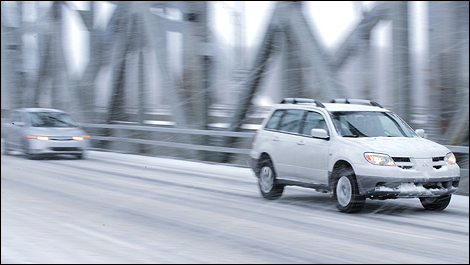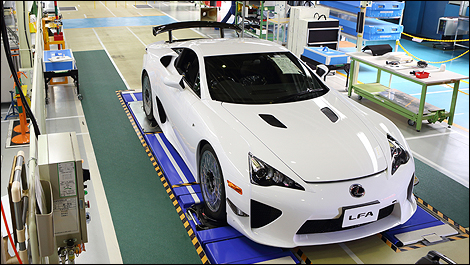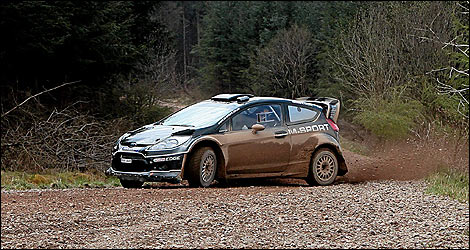With the cold, limited visibility and reduced traction of winter driving, a problem on the road can leave you and your passengers facing a world of potentially fatal problems.
Like most motorists travelling in the colder months, you'll probably escape winter at the wheel unscathed. If you're one of the unlucky ones, you may not. Don't be a statistic. Here's a look at a few potentially life-threatening problems, and how to successfully handle them.
 |
| Photo: Matthieu Lambert |
Issue: You're travelling at speed on a two-lane highway when a chunk of ice, perhaps 50 lbs in weight, slides off the roof of an oncoming transport trailer and strikes your windshield. Said windshield shatters in a contained fashion, but powdered glass finds its way into your eyes, and you're driving blind.
Solution: Know your surroundings. Ian Law is race car driver and the president and chief instructor of the
ILR Car Control School. He's been teaching drivers of all ages advanced safe driving techniques for years and he recommends a preemptive approach to successfully tackling a catastrophic non-visibility situation.
“This is one scenario where staying focused on your driving pays off in dividends. A good driver will have been focused on their driving and the situation before the incident. This is called "situational awareness," and it involves processing all driving information so that the driver knows at all times what is around them -- and where. Pilots practice this when flying and it saves lives.”
Frequent mirror-checks, being alert, and avoiding driving-related distraction all help contribute to knowing your surroundings on the move. All could save your life if you've got to get off of the road while unable to see.
Issue: It's been freezing rain for 2 hours, salt trucks are nowhere to be seen, and the rising temperatures have called a thick, soupy fog onto the roadways. You've debated pulling over for the last few kilometers, but decided to keep driving. Coming around a corner, you discover you're 3 seconds from plowing head-on into the back of an active, multi-car pileup. You're going too fast to stop.
Solution: Ditch it, now. Being entangled in a pileup with the potential for dozens of subsequent impacts is a lethal proposition, but you and your car can probably survive an impact with a ditch. Aim for it. In this situation, getting your vehicle out of the roadway is likely to offer a higher chance of survival. Pulling onto the shoulder is probably a bad idea, too.
Law adds, “You are much better off waiting 3 hours for a tow truck to pull you out of a ditch than waiting 20 minutes to have the paramedics pull your body out of the wreckage. Remember: If you stop on the shoulder, you will probably get run into.”
Issue: You drive over a large ice-boulder left on the highway by a heavy transport truck. As it passes beneath your vehicle, it strikes and perforates your brake lines, causing a leak. You're now unable to stop using your brake pedal.
Solution: Use your eyes. Look for deep snow on the shoulder of the road, gravel, or even frozen turf. If you can get out of your lane safely, these surfaces can help slow your car down. If you're lucky, the area ahead of your vehicle will be clear, so you can focus on using the emergency brake (which doesn't use the same hydraulic fluid lines) to reduce speed. Firm, steady, progressive application is best, rather than “ripping” on the handle, which can cause a skid.
Downshift your transmission (if you can) and keep your eyes up, looking for emergency paths around vehicles and structures you don't want to hit. Brake system failure isn't fun, but it can be survived with some common sense.
Issue: You've spun off an empty side-road and are now stuck in the ditch. There's no cell phone reception and you won't be able to dig your vehicle free. Snow is falling, and its frigid outside.
Solution: Stay inside. This situation is justification of three important things to do ahead of winter travels: Keep your gas tank full; always tell a friend or relative where and when you're planning to drive; and pack an emergency kit. Assuming you've done this, the best course of action is to stay inside the vehicle if it's still able to start and run.
Conserve fuel by running the engine a few minutes every hour or so, to keep the cabin warm. Clear snow from around your tailpipe periodically, which can reduce the likelihood of carbon monoxide entering the cabin. Open a window from time to time for fresh air. Don't attempt to leave the car and wander around looking for help or shelter unless visibility is back to normal.
Remember: If you run out of fuel and the cold sets in, you can use extra clothing or the blanket in your emergency kit for warmth. Keep moving your extremities to fend off hypothermia, and cover your ears, cheeks and fingertips to help prevent frostbite.


 The latest auto news, reviews, prices, product and vehicle releases.
The latest auto news, reviews, prices, product and vehicle releases. 











